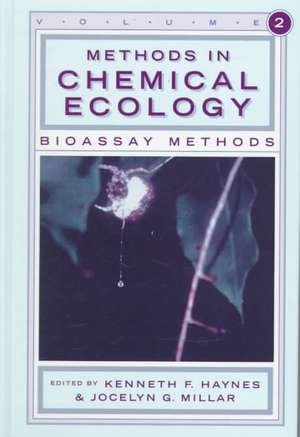Methods in Chemical Ecology Volume 2: Bioassay Methods
Editat de Kenneth F. Haynes, Jocelyn G. Millaren Limba Engleză Hardback – 30 iun 1998
| Toate formatele și edițiile | Preț | Express |
|---|---|---|
| Paperback (1) | 950.03 lei 6-8 săpt. | |
| Springer Us – 30 oct 2012 | 950.03 lei 6-8 săpt. | |
| Hardback (1) | 955.25 lei 6-8 săpt. | |
| Springer Us – 30 iun 1998 | 955.25 lei 6-8 săpt. |
Preț: 955.25 lei
Preț vechi: 1164.93 lei
-18% Nou
Puncte Express: 1433
Preț estimativ în valută:
182.79€ • 191.33$ • 152.14£
182.79€ • 191.33$ • 152.14£
Carte tipărită la comandă
Livrare economică 31 martie-14 aprilie
Preluare comenzi: 021 569.72.76
Specificații
ISBN-13: 9780412080418
ISBN-10: 0412080419
Pagini: 406
Ilustrații: XX, 406 p.
Dimensiuni: 152 x 229 x 29 mm
Greutate: 0.73 kg
Ediția:1998
Editura: Springer Us
Colecția Springer
Locul publicării:New York, NY, United States
ISBN-10: 0412080419
Pagini: 406
Ilustrații: XX, 406 p.
Dimensiuni: 152 x 229 x 29 mm
Greutate: 0.73 kg
Ediția:1998
Editura: Springer Us
Colecția Springer
Locul publicării:New York, NY, United States
Public țintă
ResearchCuprins
1. Bioassays with marine microorganisms.- 1.1. Chemical ecology of marine microorganisms.- 1.2. Ecological relevance of bioassays.- 1.3. Antimicrobial assays.- 1.4. Behavioral assays.- 1.5. Summary and conclusions.- 1.6. Acknowledgments.- 1.7. References.- 2. Bioassays with marine and freshwater macroorganisms.- 2.1. Introduction.- 2.2. Foraging cues.- 2.3. Feeding cues.- 2.4. Consequences of consuming defensive metabolites.- 2.5. Toxin-mediated prey capture.- 2.6. Chemically mediated detection of and responses to predators.- 2.7. Intraspecific chemical communication.- 2.8. Chemically mediated homing behavior.- 2.9. Settlement cues.- 2.10. Allelopathy and antifouling.- 2.11. Chemical ecology within a broader environmental context.- 2.12. Conclusions.- 2.13. Acknowledgments.- 2.14. References.- 3. Bioassay methods for fungi and oomycetes.- 3.1. Introduction.- 3.2. Intraspecific interactions—reproduction.- 3.3. Intraspecific population interactions.- 3.4. Interspecific interactions.- 3.5. Conclusions.- 3.6. Acknowledgments.- 3.7. References.- 4. Bioassays for allelopathy in terrestrial plant.- 4.1. Introduction.- 4.2. Case studies illustrating appropriate bioassays.- 4.3. Density-dependent phytotoxicity.- 4.4. Practical considerations.- 4.5. Acknowledgments.- 4.6. References.- 5. Bioassay methods with terrestrial invertebrates.- 5.1. Introduction.- 5.2. Behavioral bioassays for odors, pheromones, and other volatile compounds.- 5.3. Bioassays for contact oviposition stimulants—two case studies.- 5.4. Measurement of preference.- 5.5. Postingestive bioassays.- 5.6. Measurements in diet studies: growth rate, consumption rate, and efficiency of conversion of food to biomass.- 5.7. Alternative methods to separate preingestive and postingestive effects.- 5.8. Contact andvolatile toxicity.- 5.9. Conclusions.- 5.10. Acknowledgments.- 5.11. References.- 6. Bioassay methods for amphibians and reptiles.- 6.1. Introduction.- 6.2. Amphibians.- 6.3. Reptiles.- 6.4. Conclusions.- 6.5. Acknowledgments.- 6.6. References.- 7. Bioassays for mammals and birds.- 7.1. Introduction.- 7.2. Chemical senses.- 7.3. Test paradigms.- 7.4. Experimental apparatus.- 7.5. Intraspecific behaviors.- 7.6. Interspecific behaviors.- 7.7. Case studies.- 7.8. Summary.- 7.9. Acknowledgments.- 7.10. References.
Recenzii
`Its greatest value is as a compilation of ideas to guide future work. As such, it is ideal for advanced students in chemical ecology, but it is also very readable and would be fascinating for those with general interests in ecology.'
Journal of Environmental Quality, 28 (1999)
Journal of Environmental Quality, 28 (1999)
Notă biografică
Kenneth F. Haynes is a Professor of Entomology in the Department of Entomology, University of Kentucky, Lexington, Kentucky.













